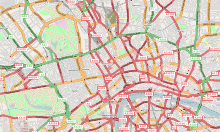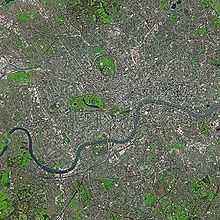

Greater London is the top-level administrative subdivision covering London. The small, ancient City of London at its core once contained the whole settlement, but as the urban area grew the City Corporation resisted attempts to amalgamate it with its suburbs, causing "London" to be defined in a number ways for different purposes; and the situation was once open to legal debate. Forty percent of Greater London is covered by the London post town, within which 'LONDON' forms part of postal addresses.
Within London, both the City of London and the City of Westminster have city status and both the City of London and the remainder of Greater London are the ceremonial counties. The current area of Greater London has incorporated areas that were once part of the counties of Middlesex, Kent, Surrey, Essex and Hertfordshire. London's status as the capital of England, and later the United Kingdom, has never been granted or confirmed officially—by statute or in written form.

Greater London covers an area of 1,579 square kilometres, an area which had a population of 7,172,036 in 2001 and a population density of 4,542 people per square kilometre. A larger area, referred to as the London Metropolitan Region or the London Metropolitan Agglomeration covers an area of 8,382 square kilometres has a population of 12,653,500 and a population density of 1,510 people per square kilometre.
London has a temperate marine climate, like much of the British Isles, so the city rarely sees extremely high or low temperatures. Summers are warm with a July high of 22.8 °C and low of 14.0 °C. But temperatures can exceed 25 °C on many days, and in almost every year they exceed 30 °C on some days. The highest temperature ever recorded was 38 °C on 10 August 2003 during the 2003 European heat wave.
Winters in London are chilly, but rarely below freezing (although in recent years this has been questionable) with daytime highs around 5 °C– 8 °C, while spring has mild days and cool evenings. The lowest ever recorded temperature was −21.1 °C in January 1795.
Autumn is usually mild but often unsettled as colder air from the arctic and warmer air from the tropics meet. London is a relatively dry city with regular but generally light precipitation throughout the year, with an average of 583.6 millimetres every year. This is lower than many cities such as New York, Paris, Sydney and around the same as Jerusalem and San Francisco.
London receives an average of only 1461 hours of sunshine every year.
You can find a little table under here with the temperatures.
| Months | Degrees (Celsius) | Density (mm) |
| Januari | 7 | 70 |
| Februari | 7 | 55 |
| March | 10 | 50 |
| April | 13 | 49 |
| May | 16 | 55 |
| June | 18 | 56 |
| July | 20 | 73 |
| August | 19 | 75 |
| September | 16 | 74 |
| October | 14 | 73 |
| November | 10 | 70 |
| December | 7 | 75 |